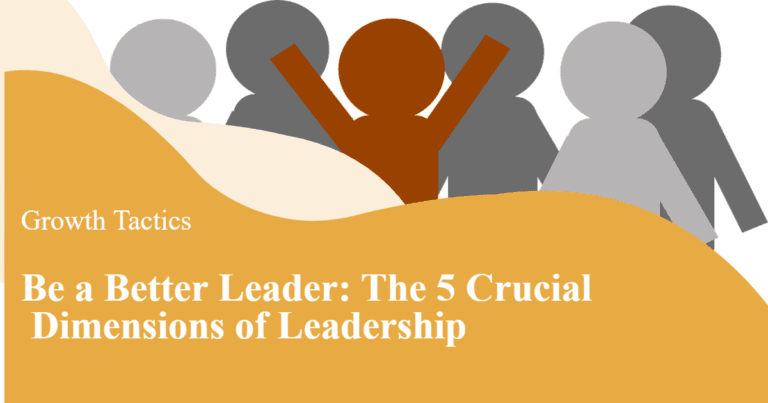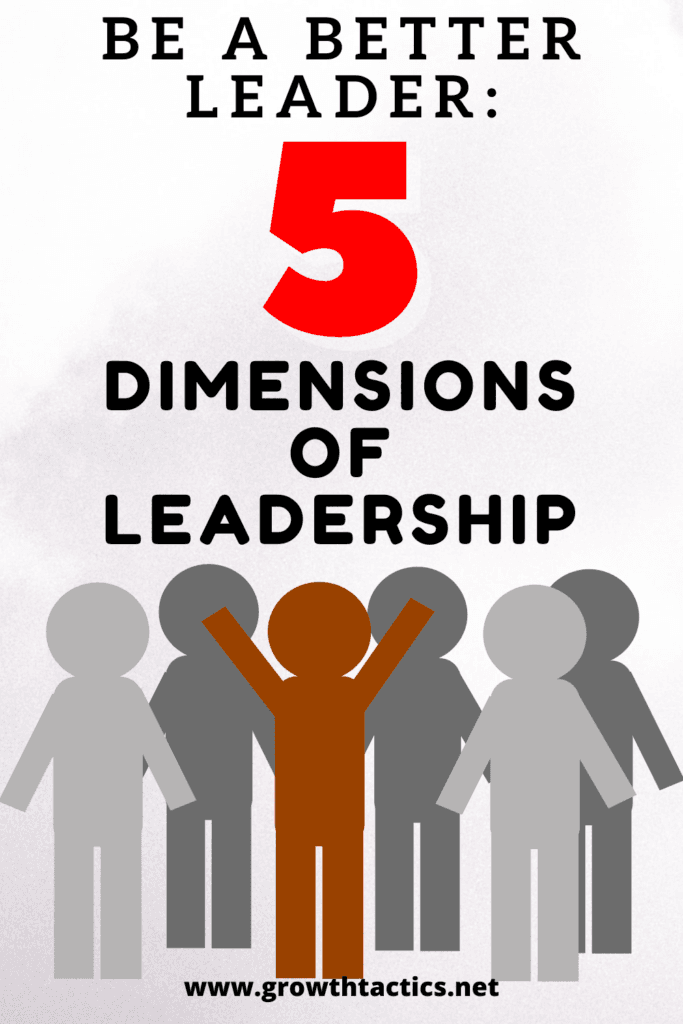Leaders shape our world. They inspire us, guide us, and help us face tough challenges. But what makes a truly great leader? The answer lies in mastering the five dimensions of leadership.
These key areas set the best apart from the rest. Whether you’re a seasoned CEO or just starting your leadership journey, understanding these dimensions will transform how you lead.
Get ready to unlock your potential and become the leader you’ve always wanted to be. Let’s get into the five crucial dimensions of leadership you need to know.
Jump To Section
Dimension 1: Visionary Thinking
Let’s kick things off with a bang – visionary thinking. This is where great leaders really shine. Think of visionary thinking as your leadership superpower. It’s all about seeing the big picture and charting a course for the future.
So, what does a visionary leader do? They don’t just focus on today’s problems. They look ahead and ask, “Where do we want to be in five years?” They paint a picture of the future that’s so vivid and exciting, it gets everyone pumped up.
But here’s the thing – having a vision isn’t enough. You need to share it in a way that lights a fire under your team. Use stories, metaphors, or even drawings if that’s your thing. The key is to make your vision so clear and compelling that your team can’t help but get on board.
Visionary thinking also means being bold. Don’t be afraid to dream big. After all, no one ever changed the world by thinking small, right?
Here’s a pro tip: carve out time each week for big-picture thinking. It’s easy to get bogged down in day-to-day stuff, but leaders must make time to look ahead.
Remember, your team is looking to you for direction. When you master visionary thinking, you don’t just lead – you inspire. You turn a group of individuals into a unified force, all working towards an exciting future. Now that’s powerful stuff!
So, are you ready to embrace your inner visionary? Trust me, it’s a game-changer in effective leadership. Your team (and your future self) will thank you for it.
Dimension 2: Emotional Intelligence
Now, let’s talk about something that’s often overlooked but super important: emotional intelligence. Think of it as your secret weapon for building great relationships and navigating tricky situations.
So, what exactly is emotional intelligence? Simply put, it’s your ability to understand and manage your own emotions, and to recognize and influence the emotions of others, a key aspect of leadership development. It’s like having a superpower that helps you read the room and connect with people on a deeper level.
Here’s why it matters: leadership isn’t just about making smart decisions. It’s about working with people. And let’s face it, people can be complicated! That’s where emotional intelligence comes in handy.
When you’ve got high emotional intelligence, you can:
- Keep your cool under pressure (no more stress-induced meltdowns!)
- Understand what makes your team tick
- Handle conflicts like a pro
- Motivate your team, even when times are tough
The good news? You can boost your emotional intelligence with practice. Start by paying attention to your own emotions. What sets you off? What calms you down? Once you understand yourself better, you’ll find it easier to understand others.
Also, try putting yourself in other people’s shoes. Ask yourself, “How would I feel in their situation?” This simple trick can work wonders for your empathy skills.
Remember, being emotionally intelligent doesn’t mean being soft or wishy-washy. It means being smart about emotions – yours and everyone else’s. It’s about using your heart and your head together to lead effectively.
So, are you ready to level up your emotional intelligence? Trust me, it’s a game-changer. Your team will appreciate having a leader who truly gets them, and you’ll find leadership a whole lot smoother sailing.
Dimension 3: Adaptive Leadership
Alright, let’s dive into something really crucial in today’s fast-paced world: adaptive leadership. Think of it as your superpower for thriving in change and uncertainty.
So, what’s adaptive leadership all about? It’s pretty simple: it’s your ability to flex and adjust your leadership style based on what’s happening around you. It’s like being a chameleon, but for leadership!
Here’s why it matters: the business world is changing at lightning speed. What worked yesterday might not work tomorrow. Adaptive leaders don’t freak out when things change – they get excited about new challenges.
When you’re an adaptive leader, you:
- Embrace change instead of running from it
- Stay cool under pressure (no panic attacks here!)
- Come up with creative solutions to new problems
- Help your team navigate uncertainty like a pro
The best part? Anyone can become an adaptive leader with practice. Start by being more open-minded. Next time you face a problem, try looking at it from different angles. Ask yourself, “What if we did things completely differently?”
Also, get comfortable with not having all the answers. It’s okay to say, “I don’t know, but let’s figure it out together.” Your team will appreciate your honesty, and you’ll all learn something new.
Remember, being an adaptive leader doesn’t mean changing your values or core beliefs. It means being flexible in how you approach challenges and lead your team.
Here’s a pro tip: make learning a habit. Read widely, try new things, and stay curious. The more you know, the better equipped you’ll be to adapt to whatever comes your way.
So, are you ready to become an adaptive leader? Trust me, it’s a game-changer. In a world where change is the only constant, adaptive leaders don’t just survive – they thrive. And your team? They’ll be right there with you, ready to take on whatever comes next.
Dimension 4: Inclusive Decision-Making
Let’s talk about something that can really make or break a team: inclusive decision-making. It’s a fancy term, but the idea is pretty straightforward. It’s all about making sure everyone has a voice when it comes to important decisions.
So, what exactly is inclusive decision-making? Well, it’s when you actively seek out and consider different perspectives before making a choice. It’s like throwing a party and making sure everyone gets an invite – no wallflowers allowed!
Why does it matter? Simple. When you include more voices, you get better decisions. Plus, your team feels valued and engaged. It’s a win-win!
Here’s what happens when you practice inclusive decision-making:
- You tap into a wider range of ideas (hello, creativity boost!)
- Your team feels more invested in the outcome
- You catch potential problems early on
- You build a culture of trust and openness
Now, I know what you’re thinking. “But won’t this slow everything down?” Sure, it might take a bit more time upfront. But trust me, it pays off big time in the long run.
So, how do you do it? Start by creating a safe space for sharing ideas. Make it clear that all input is welcome, even if it goes against the grain. Ask questions like, “What are we missing?” or “Who else should we hear from?”
Remember, inclusive decision-making doesn’t mean you need unanimous agreement on everything. You’re still the leader, and sometimes you’ll need to make the final call. But when you’ve considered all perspectives, you can make that call with confidence.
Here’s a pro tip: pay attention to who’s not speaking up. Sometimes the quietest people have the best ideas. Make an effort to draw them out.
Ready to give inclusive decision-making a try? Go for it! You might be surprised at the creative solutions your team comes up with when everyone’s voice is heard. Plus, your team will love you for it. After all, who doesn’t want to feel like their opinion matters?
Dimension 5: Ethical Leadership
Alright, let’s chat about something that’s absolutely crucial in today’s world: ethical leadership. Now, don’t roll your eyes! I know “ethics” might sound boring, but trust me, it’s anything but.
So, what’s ethical leadership all about? In a nutshell, it’s about doing the right thing, even when no one’s watching. It’s like having a strong moral compass that guides all your decisions and actions as a leader.
Why does it matter? Well, for starters, it builds trust. And in business (and life), trust is gold. When your team, customers, and partners know you’ll always do the right thing, they’ll stick with you through thick and thin.
Here’s what ethical leaders do:
- They walk the talk (no “do as I say, not as I do” here!)
- They’re honest, even when it’s tough
- They treat everyone fairly
- They take responsibility for their actions
- They care about the impact of their decisions on others
Now, being an ethical leader isn’t always easy. Sometimes, you’ll face tough choices. The “right” thing might not be the most profitable or popular thing. But here’s the kicker: in the long run, ethical leadership always pays off.
So, how do you become an ethical leader? Start by defining your values. What do you stand for? What lines won’t you cross? Once you’re clear on this, let these values guide your decisions.
Next, create a culture of ethics in your team. Encourage open discussions about ethical dilemmas. Celebrate team members who do the right thing, even if it’s hard.
Here’s a pro tip: when faced with a tough decision, ask yourself, “Would I be comfortable if this decision was on the front page of the newspaper?” If the answer is no, it’s probably not the right choice for yourself or the stakeholders.
Remember, ethical leadership isn’t about being perfect. We all make mistakes. What matters is how you handle those mistakes. Own up to them, learn from them, and do better next time.
Ready to embrace ethical leadership? Go for it! It might not always be the easiest path, but it’s definitely the most rewarding. Plus, you’ll sleep better at night knowing you’re making a positive impact. And isn’t that what great leadership is all about?
Wrapping It Up: Keep Growing, Keep Leading
So, we’ve covered a lot of ground, haven’t we? From self-awareness to ethical leadership, these five dimensions are the secret sauce of great leadership. But here’s the thing: you’re never really “done” developing these skills. It’s an ongoing journey, folks!
Why keep working on these dimensions? Well, the world’s changing fast, and leaders need to keep up. What worked yesterday might not cut it tomorrow; effective leadership requires adaptability. Plus, there’s always room for improvement, right? The best leaders are the ones who never stop learning, growing, and understanding the 5 dimensions of leadership.
Here’s the cool part: as you develop these dimensions, you’ll see ripple effects throughout your team and organization. You’ll inspire others to grow, create a more positive work environment, and achieve better results. It’s like a leadership superpower!
Remember, Rome wasn’t built in a day, and neither is great leadership. Take it one step at a time, celebrate your progress, and keep pushing forward. You’ve got this!


